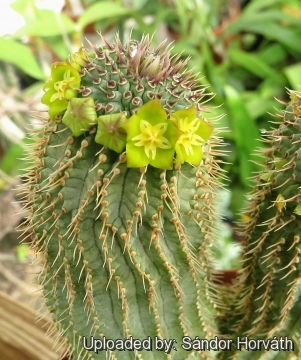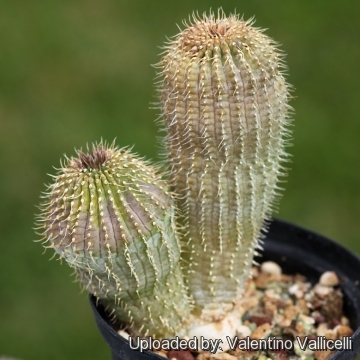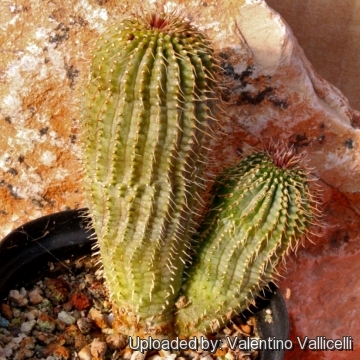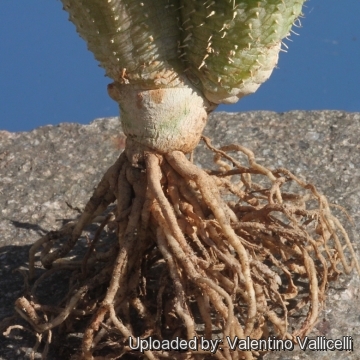Accepted Scientific Name: Hoodia flava (N.E.Br.) Plowes
Asklepios 56: 8 (1992)

Trichocaulon flavum (Hoodia flava) Photo by: Sándor Horváth
Origin and Habitat: Republic of South Africa, (Cape Province in the Karoo region from Prince Albert northwards to Kenhardt.), Namibia (Koran Mts., eastern and southern flanks of the Great Karas Mountains).
Habitat: Plants usually grow inside bushes, on gentle gravelly slopes or summits of hills.
Synonyms:
Common Names include:
AFRIKAANS (Afrikaans): Ghaap, Yellow-flowerred Ghaap
Description: Leafless and branchless, Hoodia flavaSN|18697]]SN|18697]] is a compact succulent spiny shrublet with many cylindrical stems all arising from the base. Yellow flowers appear in Winter on the youngest parts of the plants near the top. This species is distinguished from the other Hoodia species by its small yellow flowers and its unique distribution.
Stems: 3 to many, cylindrical up to 50 cm in height, but mostly much smaller (usually 15-18 cm), 2-7 cm in diameter, grey-green, armed with 18-31 vertical rows of tubercles (mammillae), that are tipped with hard, stiff, brown or black bristles 4-7 mm long. The stems closely resemble those of Hoodia piliferaSN|18887]]SN|18887]] but the spines of Hoodia flavaSN|18697]]SN|18697]] are darker.
Inflorescence: In 1-3 Flowered.
Flowers: Small, up to 12 mm in diameter, in yellow sometimes flushed brown or rarely entirely brown, disc is flat over which the the distinctive pincer-like yellow outer corona extends. Scent reminiscent of old fish.
Pedicels: 0,3-1 mm long.
Sepals: Appressed to the corolla, 2,5-3 long, basally 1-1,5 mm broad.
Corolla: Either greenish-yellow or yellowish-green and corolla lobes with brown tips, or entirely brown, 11-13 mm in diametro, dish-to bowl-shaped.
Corolla lobes: Broadly ovate-deltoid, 2,5-4 long, 3,5-5 mm broad, occasionally with fusiform tip area, inside smooth or finely papillate, papillae semiglobose with fine apical bristles.
Corona: yellow
Inner corona: 16-22 mm, divided from below the middle into 2 broad weakly dorsiventrally flattened linear horn-like appendages (appendages strongly spreading, approaching and touching each other in central position).
Outer corona-lobes: Linear, blunt, 0,6-1 mm, occasionally longer than the anthers and touching each other above the style head.
Fruit: Paired follicles 7,5-18 cm long.
Seeds: Numerous, strongly compressed, with a coma (a prominent basal tuft of silky hairs).
Subspecies, varieties, forms and cultivars of plants belonging to the Hoodia flava group
Bibliography: Major references and further lectures
1) Focke Albers, Ulrich Meve “Illustrated Handbook of Succulent Plants: Asclepiadaceae” Volume 4 Springer, 2002
2) James Cullen, Sabina G. Knees, H. Suzanne Cubey “The European Garden Flora Flowering Plants: A Manual for the Identification of Plants Cultivated in Europe, Both Out-of-Doors and Under Glass” Cambridge University Press, 11/ago/2011
3) Bruyns, P,V. “Stapeliads of Southern Africa and Madagascar.” Umdaus Press, Hatfield, South Africa. 2005.
4) G. J. H. Grubben "Vegetables" PROTA, 2004
5) 5) National Botanical Research Institute “Hoodia in Namibia” retrieved on 01/12/2013: http://www.nbri.org.na/fileadmin/user_upload/publications/Hoodia_booklet.pdf
6) Ben-Erik Van Wyk, Nigel Gericke “People's plants: a guide to useful plants of Southern Africa” Briza, 2000
7) Carr, S. “Spotlight on Agriculture” No 79. Ministry of Agriculture, Water & Forestry. 2004.
 Trichocaulon flavum (Hoodia flava) Photo by: Sándor Horváth
Trichocaulon flavum (Hoodia flava) Photo by: Sándor Horváth Trichocaulon flavum (Hoodia flava) Photo by: Valentino Vallicelli
Trichocaulon flavum (Hoodia flava) Photo by: Valentino Vallicelli Trichocaulon flavum (Hoodia flava) Photo by: Valentino Vallicelli
Trichocaulon flavum (Hoodia flava) Photo by: Valentino Vallicelli Trichocaulon flavum (Hoodia flava) Photo by: Valentino Vallicelli
Trichocaulon flavum (Hoodia flava) Photo by: Valentino VallicelliCultivation and Propagation: Water normally in the growing season, sparsely in the winter.
It is usually recommended to over-winter them in warm conditions (at 10° C), but despite their African origins they seem to grow well and flower without the extra heat which one might have thought necessary, and occasional temperatures near 0°C. are tolerated, if kept dry.
Spring: In the spring leaving them out in the rain may provide them with the water they need.
Summer: In the summer months they will grow well in partial shade and tolerate heavy rain, but will be just as happy if the season is dry.
Propagation: Easiest with stem cuttings. Allow cuttings to dry several days before planting.
Potting medium: Since roots are quite shallow, use a cactus mix, or add extra perlite or pumice to regular soil potting soil. A gritty, very free-draining compost is suitable, and clay pots help the plants to dry out between watering.
Sun Exposure: Full sun or partial shade.
Edible uses: Commonly known as: “ghaap” the young pods are liked for their sweetniss. The whole plant is also used as an appetite and thirst-suppressant.














